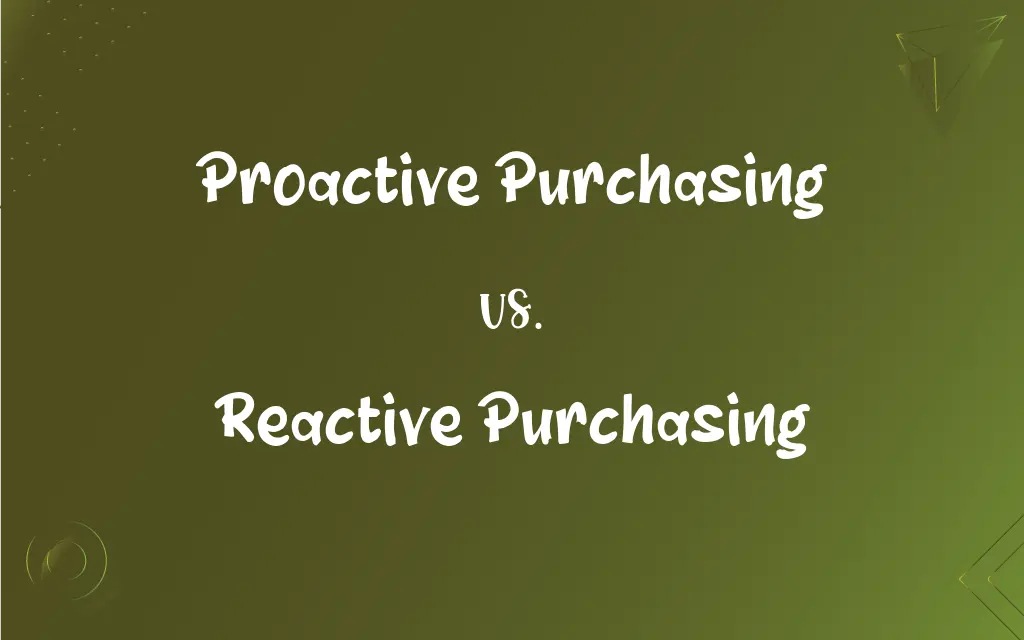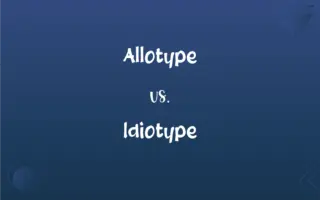Proactive Purchasing vs. Reactive Purchasing: What's the Difference?
Edited by Aimie Carlson || By Janet White || Published on March 14, 2024
Proactive purchasing involves planning and strategizing procurement in advance, while reactive purchasing responds to immediate needs or emergencies.

Key Differences
Proactive purchasing is a strategic approach to procurement that involves planning and forecasting to anticipate needs and secure resources in advance. It focuses on analyzing market trends, assessing risks, and developing long-term relationships with suppliers to ensure a steady supply of goods and services. Reactive purchasing, on the other hand, is a response to immediate or unforeseen needs. It occurs when an organization needs to quickly address a shortage, emergency, or unexpected demand. Reactive purchasing often involves expedited processes, which can lead to higher costs and compromised quality due to the urgency and lack of planning.
The main difference between proactive and reactive purchasing lies in the approach and timing. Proactive purchasing is forward-looking and preventive, aiming to avoid potential issues and capitalize on opportunities. Reactive purchasing is backward-looking and corrective, dealing with problems or demands as they arise.
Proactive purchasing requires a thorough understanding of the organization's needs, market conditions, and supplier capabilities. It involves continuous monitoring and adjustment of procurement strategies. Reactive purchasing, while sometimes necessary, can be seen as a less efficient approach due to the potential for rushed decisions and lack of strategic alignment.
Proactive purchasing is about being prepared and strategic in procurement, while reactive purchasing is about responding to immediate needs. Both approaches have their place in an organization's procurement strategy, but a proactive approach is generally preferred for its long-term benefits and cost savings.
Comparison Chart
Approach
Strategic and anticipatory
Responsive and immediate
ADVERTISEMENT
Planning
Involves long-term planning and forecasting
Lacks planning, focuses on immediate needs
Cost Efficiency
Aims to optimize costs through planning
Often incurs higher costs due to urgency
Supplier Relationships
Builds long-term partnerships with suppliers
May involve ad-hoc or one-time transactions with suppliers
Risk Management
Proactively identifies and mitigates risks
Reacts to risks as they occur
Proactive Purchasing and Reactive Purchasing Definitions
Proactive Purchasing
A strategic approach to procurement that anticipates future needs and plans accordingly.
The company's proactive purchasing strategy ensured a steady supply of raw materials, avoiding production delays.
ADVERTISEMENT
Reactive Purchasing
The process of procuring goods or services in response to immediate needs or emergencies.
The sudden breakdown of equipment forced the factory into reactive purchasing to resume operations quickly.
Proactive Purchasing
The practice of anticipating and addressing procurement needs before they become urgent.
By adopting proactive purchasing, the retailer avoided stockouts during the holiday season.
Reactive Purchasing
The act of buying goods or services as a direct response to a specific, unplanned situation.
The restaurant engaged in reactive purchasing after a sudden surge in customers depleted their food stock.
Proactive Purchasing
A method of procurement focused on long-term cost optimization and supplier relationships.
The manufacturer's proactive purchasing approach led to bulk discounts and improved product quality.
Reactive Purchasing
The practice of making procurement decisions in reaction to immediate challenges or opportunities.
The company's reactive purchasing strategy allowed them to take advantage of a last-minute discount on office supplies.
Proactive Purchasing
Strategic procurement that aligns with organizational goals and market trends.
The company's proactive purchasing policy enabled them to capitalize on early-bird discounts for new technology.
Reactive Purchasing
A procurement approach that addresses needs as they arise, without prior planning.
The school's reactive purchasing of laptops ensured that students could continue learning during the unexpected lockdown.
Proactive Purchasing
Procurement planning that involves forecasting demand and securing resources in advance.
Through proactive purchasing, the hospital maintained an adequate stock of essential medicines, even during the pandemic.
Reactive Purchasing
Procurement that occurs when unforeseen circumstances create an urgent demand.
The flood damage prompted reactive purchasing of cleaning supplies and repair materials.
FAQs
What is proactive purchasing?
Proactive purchasing is a strategic approach to procurement that involves planning and forecasting to anticipate and meet future needs.
Can proactive purchasing lead to cost savings?
Yes, proactive purchasing can lead to cost savings through bulk buying, early-bird discounts, and avoiding rush charges.
How do proactive and reactive purchasing differ in terms of planning?
Proactive purchasing involves long-term planning and forecasting, while reactive purchasing lacks planning and focuses on immediate needs.
What is reactive purchasing?
Reactive purchasing is the process of procuring goods or services in response to immediate needs or emergencies, without prior planning.
Is reactive purchasing always more expensive?
Reactive purchasing can often be more expensive due to urgency, but it may be necessary in certain situations.
Can an organization use both proactive and reactive purchasing?
Yes, an organization can use both approaches, with proactive purchasing as the primary strategy and reactive purchasing for unforeseen needs.
How does proactive purchasing contribute to risk management?
Proactive purchasing identifies and mitigates risks by ensuring a steady supply of goods and services, reducing the likelihood of shortages.
Can reactive purchasing be strategic in certain situations?
Yes, reactive purchasing can be strategic when it allows an organization to take advantage of unexpected opportunities or deals.
How do proactive and reactive purchasing affect supplier relationships?
Proactive purchasing fosters long-term partnerships with suppliers, while reactive purchasing may involve ad-hoc transactions.
Can proactive purchasing help in building a sustainable supply chain?
Yes, proactive purchasing can contribute to sustainability by allowing for the selection of eco-friendly suppliers and materials.
How can an organization transition from reactive to proactive purchasing?
An organization can transition by implementing a procurement strategy, investing in technology, and training staff in forecasting and planning.
What role do procurement policies play in proactive purchasing?
Procurement policies provide guidelines and frameworks for proactive purchasing, ensuring consistency and alignment with organizational goals.
What skills are essential for effective proactive purchasing?
Essential skills include strategic planning, market analysis, negotiation, risk management, and supplier relationship management.
What role does market analysis play in proactive purchasing?
Market analysis is crucial in proactive purchasing to understand trends, forecast demand, and make informed procurement decisions.
How can reactive purchasing be minimized?
Reactive purchasing can be minimized through better planning, improved forecasting, and maintaining safety stock levels.
What are the benefits of proactive purchasing for an organization?
Benefits of proactive purchasing include cost savings, improved supply chain stability, better quality control, and stronger supplier relationships.
How does technology impact proactive purchasing?
Technology, such as procurement software and data analytics, can enhance proactive purchasing by providing real-time insights and automating processes.
What challenges are associated with proactive purchasing?
Challenges include accurately forecasting demand, managing inventory levels, and adapting to market changes.
How does reactive purchasing impact inventory management?
Reactive purchasing can lead to overstocking or stockouts, affecting inventory management and potentially increasing costs.
How do economic factors influence proactive and reactive purchasing?
Economic factors, such as inflation and market volatility, can impact both approaches by affecting prices, availability, and demand.
About Author
Written by
Janet WhiteJanet White has been an esteemed writer and blogger for Difference Wiki. Holding a Master's degree in Science and Medical Journalism from the prestigious Boston University, she has consistently demonstrated her expertise and passion for her field. When she's not immersed in her work, Janet relishes her time exercising, delving into a good book, and cherishing moments with friends and family.
Edited by
Aimie CarlsonAimie Carlson, holding a master's degree in English literature, is a fervent English language enthusiast. She lends her writing talents to Difference Wiki, a prominent website that specializes in comparisons, offering readers insightful analyses that both captivate and inform.































































